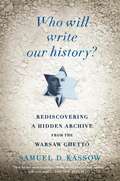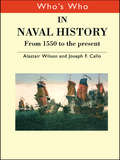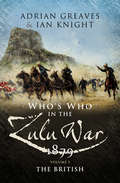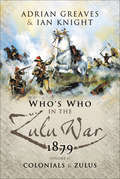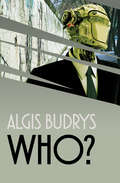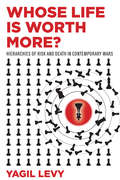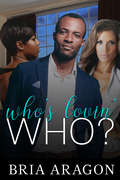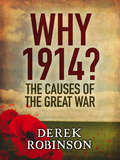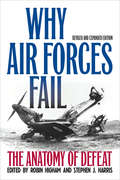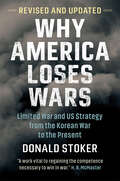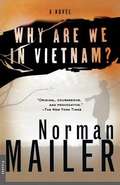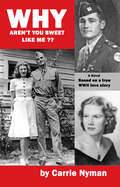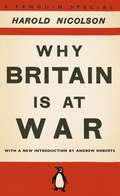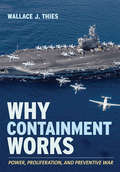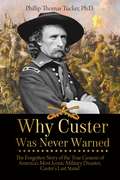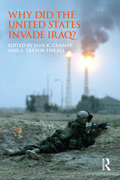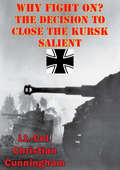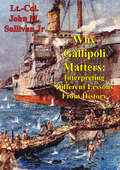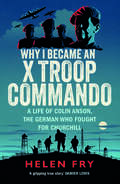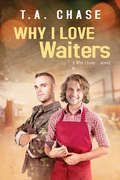- Table View
- List View
Who Will Write Our History? Rediscovering a Hidden Archive from the Warsaw Ghetto
by Samuel D. KassowIn 1940, in the Jewish ghetto of Nazi-occupied Warsaw, the Polish historian Emanuel Ringelblum established a clandestine scholarly organization called the Oyneg Shabes to record the experiences of the ghetto's inhabitants. For three years, members of the Oyneb Shabes worked in secret to chronicle the lives of hundereds of thousands as they suffered starvation, disease, and deportation by the Nazis. Shortly before the Warsaw ghetto was emptied and razed in 1943, the Oyneg Shabes buried thousands of documents from this massive archive in milk cans and tin boxes, ensuring that the voice and culture of a doomed people would outlast the efforts of their enemies to silence them. Impeccably researched and thoroughly compelling, Samuel D. Kassow's Who Will Write Our History? tells the tragic story of Ringelblum and his heroic determination to use historical scholarship to preserve the memory of a threatened people.
Who's Who in Naval History: From 1550 to the present
by Alastair Wilson Joseph F. CalloThis A-Z guide covers the life and careers of over 600 key figures in naval history, from the sixteenth century to the present day. Featuring influential figures from the UK, US and around the world, from the great admirals such as Nelson, to minesweepers, designers and administrators, it is an invaluable guide to those who have shaped naval history.
Who's Who in Nazi Germany
by Robert S. WistrichWho's Who in Nazi Germany looks at the individuals who influenced every aspect of life in Nazi Germany. It covers a representative cross-section of German society from 1933-1945, and includes:* Nazi Party leaders; SS, Wehrmacht and Gestapo personalities; civil service and diplomatic personnel* industrialists, churchmen, intellectuals, artists, entertainers and sports personalities* resistance leaders, political dissidents, critics and victims of the regime* extensive biographical information on each figure extending into the post-war period* analysis of their role and significance in Nazi Germany* an accessible, easy to use A-Z layout* a glossary and comprehensive bibliography.
Who's Who in the Zulu War, 1879: Vol 1 - The British
by Ian Knight Adrian GreavesThe Anglo-Zulu War of 1879 has a character that inspires and fascinates readers and increasing numbers of visitors to South Africa. The two volume biographical dictionary of the participants is a unique venture and this second volume reveals much about the formidable Zulu nation which so nearly humbled the mighty British Empire which had provoked the conflict.Thanks to the deep knowledge and research abilities of the two authors this fascinating book provides detail on both the leaders of the Zulu armies, which totaled some 40,000 warriors. We learn of the terrible price paid by this proud nation not just from the defeat by the British but in the civil war of 1883 brought about as a result of the internal tensions unleashed by the Zulu War.The role of the Colonials, be they British settlers, Boer or non-Zulu Africans is also examined through highly informative entries on the main personalities.
Who's Who in the Zulu War, 1879: Vol 2 - The Colonials And The Zulus
by Ian Knight Adrian GreavesThe Anglo Zulu War continues to attract phenomenal interest. What was meant to be a quick punitive expedition led by Lord Chelmsford turned into a watershed for British Colonial power. The ignominious defeat at Iswandhlwana was a terrible blow to British military pride but the heroic stand at Rourkes Drift, while a minor event by comparison, allowed the powers-that-be to salvage some honor.This authoritative book covers all the main players, be they military, political or civilian, with concise yet readable individual entries. In addition to the military commanders on both sides, we have the VC winners, those at Rourkes Drift and survivors of the massacre. Individuals such as The Crown Prince Imperial whose actions made an impact all have entries.
Who?
by Algis BudrysSet against a backdrop of Cold War paranoia, this futuristic novel about identity and technology is &“one of the unrecognized classics of SF&” (Locus). East and West have fused into separate superstates known as the Allied National Government (ANG) and the Soviet International Bloc (SIB). As the Cold War rages, brilliant scientist Lucas Martino works on a top-secret project known only as K-Eighty-eight that could alter the balance of world power. The project goes horribly awry at an Allied research facility near the Soviet border, and Martino is abducted. After several months of tense negotiations, he returns severely injured from the lab explosion, and under pressure from America, undergoes extensive reconstructive surgery. He has a mechanical arm. His polished metal skull—a kind of craniofacial prosthesis—contains few discernable features. Several of his internal organs are artificial. While his fingerprints are identified as belonging to Lucas Martino, they could be the result of transplant. Is he the real Martino? Or a technologically altered imposter sent by America&’s enemies for the purpose of spying and infiltration? Tasked with uncovering the truth, ANG Security Chief Shawn Rogers makes some shocking discoveries. Narrated in chapters alternating between Rogers and Martino, Who? poses existential questions about the human condition.
Whom the Gods Would Destroy
by Richard PowellFrom the book jacket: Thirty-two hundred years ago, the people of a shining civilization apparently set out to prove the truth of the saying that whom the Gods would destroy, they first make mad The civilization was the long-forgotten one that is now called Mycenaean. The madness that destroyed it was the Trojan War. Richard Powell has gone back to this fabled period to write a big and colorful and lovingly-researched novel of its people and events. His central character is Helios, a kitchen boy in the palace at Troy, who may or may not be a bastard son of Priam, the High King. The story begins two years before the Trojan War, when Helios is eight, and carries him through boyhood and adolescence until he reaches manhood on the terrible night when Troy falls. His search for an identity, for knowledge, and for friendship and love, weaves in and out of the great events sung by the Homeric bards, giving a new perspective and depth to them. One of the author's aims in writing this book was to introduce modern readers to the golden people of the Iliad and Odyssey and Aeneid. Nearly all of them are here--Achilles and Odysseus, Agamemnon and Menelaus, Hector, Paris, Helen, Great Ajax and Little Ajax, Cassandra, Aeneas--and they are depicted from a fresh viewpoint. Is Achilles, for example, simply the overpowering hero of legend, or is he a more complicated person touched with manic-depressive insanity? Does the saying "Wise as Nestor" properly describe that ruler, or did the Homeric bards mean to show him as a talkative and comic fool? Is Agamemnon a great and tragic king, or one of history's worst blunderers? What motivated Helen of Troy and accounted for her strange power over men? The answers to these and other questions are part of the rich fabric of the story. As recently as a few decades ago a book such as this could not have been written, because there were huge gaps in our knowledge of Mycenaean civilization. For example, no one even knew whether or not the people of Mycenaean times had a system of writing. In the past twenty-five years, however, a mass of information has come to light, and Powell has studied it thoroughly. As part of his research he visited every major museum in the Aegean area, and went to all the digs-Troy, Mycenae, Pylos, Tiryns, Knossos-where Schliemann and Dorpfeld and Sir Arthur Evans and Blegen and other great archeologists uncovered the secrets of the past.
Whose Life Is Worth More?: Hierarchies of Risk and Death in Contemporary Wars
by Yagil LevyModern democracies face tough life-and-death choices in armed conflicts. Chief among them is how to weigh the value of soldiers' lives against those of civilians on both sides. The first of its kind, Whose Life Is Worth More? reveals that how these decisions are made is much more nuanced than conventional wisdom suggests. When these states are entangled in prolonged conflicts, hierarchies emerge and evolve to weigh the value of human life. Yagil Levy delves into a wealth of contemporary conflicts, including the drone war in Pakistan, the Kosovo war, the Israeli-Palestinian conflict, and the US and UK wars in Iraq and Afghanistan. Cultural narratives about the nature and necessity of war, public rhetoric about external threats facing the nation, antiwar movements, and democratic values all contribute to the perceived validity of civilian and soldier deaths. By looking beyond the military to the cultural and political factors that shape policies, this book provides tools to understand how democracies really decide whose life is worth more.
Who’s Lovin’ Who?
by Bria AragonJourney Duval and Dondre Collins are reinventing their relationship as they attend separate reunions in Myrtle Beach. Sexy fun is interrupted by the one who turned their lives upside down in the first place: Kamryn Woods, their former love. Will her shocking news undermine everything, or can this fractured trio learn to live happily ever after?Author Note: “Bria Aragon” created their story line as a television series in the full-length novel A Couple of Forevers.
Why 1914?
by Derek RobinsonIn Why 1914?, Derek Robinson--trained as a historian, shortlisted for the Booker Prize--applies his novelist's skills to asking how and why Europe hurried into such a massive disaster. He captures a world of kings and Kaisers, generals and infantrymen. None of them knew what a big European war meant. All the combatant nations assumed it would be short, and each expected to win. The roots of such folly began in the nineteenth century. Robinson traces the earliest warning signs, leading to a sudden crisis and an impulsive war that went massively wrong from the start. This book is the ideal introduction to the key question of the Great War: why did Europe explode?
Why 1914?: The Causes of the Great War
by Derek RobinsonShort, brisk and highly readable, this account stands out from the flood of books written for the Centenary of the Great War. In Why 1914?, Derek Robinson - trained as a historian, shortlisted for the Booker Prize - applies his novelist's skills to asking how and why Europe hurried into such a massive disaster. He captures a world of kings and Kaisers, generals and infantrymen. None of them knew what a big European war meant. All the combatant nations assumed it would be short, and each expected to win. The roots of such folly began in the nineteenth century. Robinson traces the earliest warning signs, leading to a sudden crisis and an impulsive war that went massively wrong from the start. This book is the ideal introduction to the key question of the Great War: why did Europe explode?
Why 1914?: The Causes of the Great War
by Derek RobinsonShort, brisk and highly readable, this account stands out from the flood of books written for the Centenary of the Great War. In Why 1914?, Derek Robinson - trained as a historian, shortlisted for the Booker Prize - applies his novelist's skills to asking how and why Europe hurried into such a massive disaster. He captures a world of kings and Kaisers, generals and infantrymen. None of them knew what a big European war meant. All the combatant nations assumed it would be short, and each expected to win. The roots of such folly began in the nineteenth century. Robinson traces the earliest warning signs, leading to a sudden crisis and an impulsive war that went massively wrong from the start. This book is the ideal introduction to the key question of the Great War: why did Europe explode?
Why Air Forces Fail: The Anatomy of Defeat
by Robin Higham and Stephen J. HarrisIncludes two new chapters! &“One of the more interesting and better books on military aviation to appear in the last few years.&”—Journal of Military History Since the publication of the first edition of Why Air Forces Fail, the debate over airpower&’s role in military operations has only intensified. Here, eminent historians Robin Higham and Stephen J. Harris assemble a team of experts to add essential new details to their cautionary tale for current practitioners of aerial warfare. Together, the contributors examine the complex, often deep-seated, reasons for the catastrophic failures of the Russian, Polish, French, British, Italian, German, Argentine, and American air services. Complemented by reading lists and suggestions for further research, this seminal study with two new chapters provides an essential and detailed analysis of defeat. &“Contains many interesting insights and interpretations . . . an excellent introduction to the study of military failure in general and air forces in particular.&”—Journal of America&’s Military Past &“I recommend this book to those who are interested in air forces and air power, whether amateur or professional, past, present and future.&”—Richard Cobbold, Bryanston: The Yearbook &“Provides an excellent analysis of the root causes of failure; this engaging study goes far beyond the aerial battlefield to examine the circumstances leading to defeat.&”—Dennis Drew, Colonel, USAF (Ret.)
Why America Loses Wars: Limited War and US Strategy from the Korean War to the Present
by Donald StokerHow can you achieve victory in war if you don't have a clear idea of your political objectives and a vision of what victory means? In this provocative challenge to US policy and strategy, Donald Stoker argues that America endures endless wars because its leaders no longer know how to think about war, particularly limited wars. He reveals how ideas on limited war and war in general evolved against the backdrop of American conflicts in Korea, Vietnam, and Iraq. These ideas, he shows, were flawed and have undermined America's ability to understand, wage, and win its wars, and to secure peace afterwards. America's leaders have too often taken the nation to war without understanding what they want or valuing victory, leading to the 'forever wars' of today. Why America Loses Wars dismantles seventy years of misguided thinking and lays the foundations for a new approach to the wars of tomorrow.
Why America Loses Wars: Limited War and US Strategy from the Korean War to the Present
by Donald StokerHow can you achieve victory in war if you don't have a clear idea of your political aims and a vision of what victory means? In this provocative challenge to US political aims and strategy, Donald Stoker argues that America endures endless wars because its leaders no longer know how to think about war, particularly wars fought for limited aims, taking the nation to war without understanding what they want or valuing victory and thus the ending of the war. He reveals how flawed ideas on so-called 'limited war' and war in general evolved against the backdrop of American conflicts in Korea, Vietnam, Iraq, and Afghanistan. These ideas, he shows, undermined America's ability to understand, wage, and win its wars, and to secure peace. Now fully updated to incorporate the American withdrawal from Afghanistan, Why America Loses Wars dismantles seventy years of misguided thinking and lays the foundations for a new approach to the wars of tomorrow.
Why Are We in Vietnam? A Novel
by Norman MailerWhen "Why Are We in Vietnam?" was published in 1967, almost twenty years after "The Naked and the Dead," the critical response was ecstatic. The novel fully confirmed Mailer's status as one of the most important figures in contemporary American literature. Now, a new edition of this exceptional work serves as further affirmation of its timeless quality. Narrated by Ranald ("D.J.") Jethroe, Texas's most precocious teenager, on the eve of his departure to fight in Vietnam, this story of a hunting trip in Alaska is both brilliantly entertaining and profoundly thoughtful.
Why Aren't You Sweet Like Me??: A Novel
by Carrie NymanA pair of newlyweds are separated by war in this emotional, evocative novel inspired by a true WWII love story. Camille &“Honey&” Shaughnessy and Don Shepard fall in love and marry on the eve of World War II. As America enters the war, and Don is pressured into the service by his father, the two newlyweds struggle to maintain contact. Thousands of miles away, Don becomes a hero, saving the lives of his comrades—but, Honey worries, will he make it back to her alive? Moving and memorable, Why Aren&’t You Sweet Like Me?? is a novel based on the actual love letters exchanged between the author&’s grandparents.
Why Britain is at War: With a New Introduction by Andrew Roberts
by Harold Nicolson"If we in Great Britain are resolute and wise there will emerge from this catastrophe something which may well give hope to the world" First published in 1939 as a Penguin Special, this is the original best-selling account of why Britain went to war with Germany. In simple terms it describes the stages of Adolf Hitler's ruthless pursuit for power, identifies his methods of deception and false diplomacy, and details his terrifying use of force that rendered peaceful negotiation increasingly difficult, and finally impossible. Shining a light on Hitler's early life and character, Harold Nicolson reveals the dictator's political theories in Mein Kampf, and explains the strategies he adopted in seizing the Rhineland, Austria, Czechoslovakia and later Poland. Written with clarity and insight, and read widely by soldiers during World War II, the final message of hope and peace is as relevant today as it was in 1939.This facsimile edition includes a new introduction by Andrew Roberts, best-selling author of The Storm of War; Masters and Commanders and Hitler and Churchill: Secrets of Leadership.
Why Containment Works: Power, Proliferation, and Preventive War (Cornell Studies in Security Affairs)
by Wallace J. ThiesWhy Containment Works examines the conduct of American foreign policy during and after the Cold War through the lens of applied policy analysis. Wallace J. Thies argues that the Bush Doctrine after 2002 was a theory of victory—a coherent strategic view that tells a state how best to transform scarce resources into useful military assets, and how to employ those assets in conflicts. He contrasts prescriptions derived from the Bush Doctrine with an alternative theory of victory, one based on containment and deterrence, which US presidents employed for much of the Cold War period. There are, he suggests, multiple reasons for believing that containment was working well against Saddam Hussein's Iraq after the first Gulf War and that there was no need to invade Iraq in 2003.Thies reexamines five cases of containment drawn from the Cold War and the post-Cold War world. Each example, Thies suggests, offered US officials a choice between reliance on traditional notions of containment and reliance on a more forceful approach. To what extent did reliance on rival theories of victory—containment versus first strike—contribute to a successful outcome? Might these cases have been resolved more quickly, at lower cost, and more favorably to American interests if US officials had chosen a different mix of the coercive and deterrent tools available to them? Thies suggests that the conventional wisdom about containment was often wrong: a superpower like the United States has such vast resources at its disposal that it could easily thwart Libya, Iraq, and Iran by means other than open war.
Why Custer Was Never Warned: The Forgotten Story of the True Genesis of America's Most Iconic Military Disaster, Custer's Last Stand
by Phillip Thomas TuckerFor the first time, this ground-breaking book tells the forgotten story of the true genesis of the June 25, 1876 disaster along the Little Bighorn, "Custer's Last Stand." The failure of the southern column to continue to advance north after the battle of the Rosebud set the stage for the annihilation of George Armstrong Custer and his five companies of the 7th Cavalry at the Little Bighorn. For nearly 150 years, almost everything possible already has been written about the fascinating story of "Custer's Last Stand" except the analysis and new views that have been emphasized in this most revealing book: the true causes and culprits of the bloody fiasco at the Little Bighorn on June 25, 1876 that shocked the American nation like no other post-Civil War event. Phillip Thomas Tucker, Ph.D., the author of nearly 30 books and including award winners, has contributed many fresh and new views about "Custer's Last Stand," revealing what has long been most often left out of the historical record. Where possible, Tucker has relied on primary source material, including period newspapers, to enlighten readers about the most forgotten and overlooked causes of Lieutenant George Armstrong Custer's and his command's annihilation in the bloody showdown along the Little Bighorn. These new explanations and fresh interpretations about how and why the battle of the Little Bighorn,perhaps the most controversial battle in American history, ultimately played out so disastrously like a Greek tragedy. Therefore, the author has exposed those individuals, America's leading military and civilian officials, who were most responsible for the greatest military disaster in the post-Civil War period. Dr. Tucker has presented the unvarnished truths about what really happened and exactly why by revealing the Machiavellian currents and dark threads of a needless war that had been artificially manufactured against the Sioux by America's top leaders, including the president, to gain their territory, especially the Black Hills. Tucker has presented the most forgotten story (literally the story inside the story) of the 1876 Sioux Campaign and "Custer's Last Stand." In this way, he has provided us with a new understanding of exactly why Custer died on a lonely hilltop beside his most faithful followers, revealing the most overlooked truths that have been long ignored. Even more, this ground-breaking book has demonstrated how Custer became the convenient scapegoat for the monumental disaster, while the true culprits in contrast successfully maintained their reputations and paths to career advancement. With considerable insight and a long-demonstrated penchant for myth-busting,Tucker has demolished the myth which stubbornly persists to this day that Custer was the foolish glory hunter, who deserved sole blame for the fiasco along the Little Bighorn. This book has overturned some of the oldest misconceptions and falsehoods to present a fresh look of George Armstrong Custer and one of the most controversial campaigns and battles in American history. For the first time and despite all of the voluminous amount of literature about Custer and the famous last stand, this book brings the reader of today much closer to a more accurate and truer understanding of how and why Custer and his five companies of the 7th Cavalry were wiped out to the last man on a hot summer afternoon in the Montana Territory.
Why Did the United States Invade Iraq? (Routledge Global Security Studies)
by A. Trevor Thrall Jane K. CramerThis edited volume presents the foremost scholarly thinking on why the US invaded Iraq in 2003, a pivotal event in both modern US foreign policy and international politics. In the years since the US invasion of Iraq it has become clear that the threat of weapons of mass destruction was not as urgent as the Bush administration presented it and that Saddam Hussein was not involved with either Al Qaeda or 9/11. Many consider the war a mistake and question why Iraq was invaded. A majority of Americans now believe that the public were deliberately misled by the Bush administration in order to bolster support for the war. Public doubt has been strengthened by the growing number of critical scholarly analyses and in-depth journalistic investigations about the invasion that suggest the administration was not candid about its reasons for wanting to take action against Iraq. This volume begins with a survey of private scholarly views about the war’s origins, then assesses the current state of debate by organising the best recent thinking by foreign policy and international relations experts on why the US invaded Iraq. The book covers a broad range of approaches to explaining Iraq – the role of the uncertainty of intelligence, cognitive biases, ideas, Israel, and oil, highlighting areas of both agreement and disagreement. This book will be of much interest to students of the Iraq War, US foreign and security policy, strategic studies, Middle Eastern politics and IR/Security Studies in general.
Why Fight On? The Decision To Close The Kursk Salient
by Lieutenant Colonel Christian CunninghamThe Battle of Kursk in July of 1943 was a pivotal battle in the Russian-German conflict, 1941-1945. After the German attack failed, the Russians responded with a major offensive and gained the strategic initiative. From then on, the German army was only capable of a series of defensive stopping actions in failed attempts to thwart the advancing Red Army. The inevitable outcome was the fall of Berlin in May of 1945. There were a number of options Hitler and the German high command could have chosen in lieu of attack. The decision to choose offensive action becomes even more interesting upon examination of Germany's strategic situation. Tunisia, the last vestige of the German occupation of North Africa, was lost and Allied offensive action on the European continent was a real and imminent threat. There were also attrition issues, production problems, and differences of opinion between Hitler and key German generals. Finally, the northern and southern shoulders of the Kursk salient, the chosen points of attack, were heavily defended. What compelled Hitler and the German High Command to take such a gamble? What were the strategic issues that guided this decision? Was the outcome decisive? And finally, what other actions might have altered the outcome of the conflict?
Why Gallipoli Matters: Interpreting Different Lessons From History
by Lieutenant Colonel John M. Sullivan Jr USMCAfter careful study of the Gallipoli Campaign of 1915, why did the British and the Americans come up to contradictory operational conclusions regarding the future applicability of amphibious operations? Divergent views from the lessons of Gallipoli campaign are the result of three differing operational approaches to strategic considerations that Britain and the Unites States faced in the 1920s and 1930s. The first were different theater strategic objectives that required different operational campaigns necessary to achieve each. The second was different operational experiences, which caused one side to focus on the past while the other to the future. The final was the different means available to operational commanders to execute their campaign.History can often provide contradictory lessons to those who wish to use it to practically apply operational art. Using analogies correctly is important. For the operational commander, drawing the correct lessons learned is made even more difficult by the very nature of inter-service rivalry. Derived from an analysis of the operational art and at operational level of war, the lessons learned from this campaign led directly to the development of sound doctrine, which developed in peacetime was absolutely essential in wartime. Finally, we continue to learn from failure more often than through success, but we must not allow ourselves to be intimidated by failure either.
Why I Became an X Troop Commando: A Life of Colin Anson, the German who Fought for Churchill
by Helen FryA fascinating and moving biography of Colin Anson, the German refugee who became an elite British commando Born in Germany in 1922, Colin Anson&’s (Claus Ascher) childhood was marked by the trials of Nazism. His father was arrested by the Gestapo in 1937 and transported to Dachau, where he died shortly after. Colin, aged just seventeen, escaped to Britain in the Kindertransport. As soon as he was old enough, Colin volunteered in the Pioneer Corps. Then, in 1942, he was recruited for the elite commando unit X-Troop. Colin took part in the invasions of Sicily and Italy in 1943, where he sustained a near-fatal injury. But just months later, he returned to duty. He fought in the Yugoslav islands, became the first Allied soldier to liberate Corfu, and was stationed in postwar Frankfurt. In this unique biography, Helen Fry traces the remarkable story of Colin&’s life. Drawing on extensive interviews, Fry recounts his actions in X-Troop and beyond in his own words—and sheds new light on the experience of refugees in the British forces.
Why I Love Waiters (Why I Love...)
by T. A. Chase2nd EditionA Why I Love.... NovelAs a member of a covert military unit, John Davidson isn’t scared of much. Yet one look into Heath Kane’s dark blue eyes and he knows a different kind of fear for the first time. John can’t be gay, at least not out and proud in his unit, even with Don’t Ask, Don’t Tell repealed. He’s never been interested enough in any man to risk the fallout. Heath’s hometown wasn’t the best place for a gay kid to grow up, but his grandmother did her darnedest to make it good for him. Now he’s paying her back for all her love. She’s getting older and needs help, so he returns home to wait tables at the Corner Café while taking online courses to get his degree. Even though the Army base provides him with a lot of buff eye candy, he knows it’s best to keep his head down. Neither Heath nor John can deny their attraction, and John’s finally willing to act on their mutual interest. But holding on to each other will mean big changes in both their lives.First Edition published by Amber Quill Press/Amber Allure, 2011.
